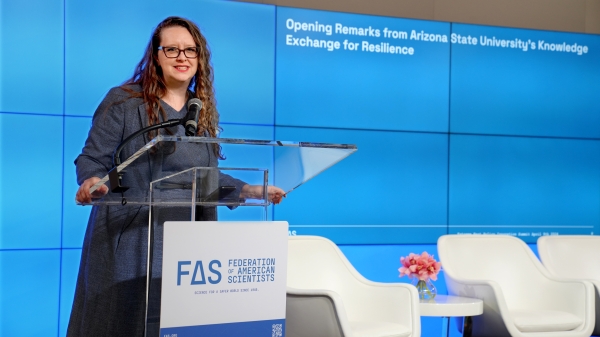The ethics of eating chocolate on Valentine’s Day
ASU lecturer walks consumers through the process of taking chocolate from bean to bar; says business side is ‘not a pretty picture’

Valentine’s Day is upon us, and that means chocolate.
Before you take that first delectable bite to satisfy your sweet tooth, you might want to consider how many hours of labor go into taking chocolate from bean to bar.
And if you don’t know, there’s someone at Arizona State University who does.
Rhian Stotts is a lecturer in anthropology and global health in the School of Human Evolution and Social Change. In high school, she dreamed of being either an archaeologist or a chocolatier. Through a program at her high school in Worthington, Ohio, she was able to spend the second semester of her senior year doing two nine-week internships exploring both fields. Her love of archaeology ultimately won out, but her interest in chocolate has always remained. Now she uses chocolate as a medium to discuss many aspects of human culture in her courses at ASU.
ASU Now spoke to Stotts about the origins of chocolate, how it is made, what it takes to bring it to market and — most importantly — is it ethical to eat chocolate on Valentine's Day (or any other day for that matter)?
Rhian Stotts
Question: How should we classify chocolate? As food? A product? A luxury item?
Answer: I typically talk about chocolate as a food item, though when I am talking to students about food items, I’m typically talking about food as both a biological necessity and food and eating as a symbolic act.
For example, in my Introduction to Cultural Anthropology course, I’ve used the exchange of chocolate on the holidays of Halloween and Valentine’s Day to explore how these exchanges take on different meanings in each of these contexts. I’m also leading a study abroad program this summer in Paris where we are focusing on food and culture; we will be focusing on artisan chocolate as a luxury food item and how the French have used chocolate to define and redefine French identity within a European and global framework.
Chocolate, like other food items, is also a product, though, and so it is important to consider the food chain of modern chocolate — where and how chocolate is produced and for whom, which is an issue we discuss in my course, Ethics of Eating.
Q: When was chocolate originally produced for a mass market, and how did this New World item catch on over the centuries?
A: First, I think it’s important to say that the earliest evidence of cacaoThe cacao tree is the source of cacao beans, the seeds of the tree which are used to make cocoa, chocolate and cocoa butter. consumption comes to us from pre-Hispanic Mesoamerica, where residue analysis and ceramic vessel form suggest consumption of a chocolate drink. Invading Spaniards in the 16th century appear to have learned about cacao from the Aztecs, who called the beverage chocolatl.
It appears that the drink wasn’t much appreciated by these invaders, though they brought it back to Spain, where sugar was added, and it became a drink of the aristocracy and began spreading through Europe. It wasn’t until the 1800s that food chemists were able to turn the drink into what we now know as the chocolate bar. The Industrial Revolution and factory-level chocolate production really helped to make chocolate production easier and more available to the general public. Though nowadays, many of the products marketed as chocolate have more sugar and flavor additives than actual cacao.
Q: Since chocolate is a luxury and not a food staple, how does it tax the land and the farmers?
A: While chocolate is a luxury item, it is also one that people who have the income tend to indulge in a lot. For example, research has shown that the average American eats the equivalent of about 120 bars of chocolate a year. Also, I think it is important to recognize that many of our agricultural products, even for staple foods, tax the land and that there are many unfair labor practices in agricultural production. All that being said, cocoa production has spread from Latin America to West Africa and Southeast Asia and has led to deforestation in all of these areas. Cacao farming is also quite difficult, and harvesting must be done by hand. Unfortunately, research has shown that much of this production is done under unfair labor practices. For example, over 70 percent of the world’s cocoa is produced in West Africa, where it is estimated that approximately 2.1 million children are involved in the industry, often in slave-like conditions.
Q: What does the business side of making chocolate look like?
A: Unfortunately, the business side of chocolate is generally not a pretty picture. Chocolate is a $100 billion industry, and as with much of our food production nowadays, the supply chain between the producers and the consumers is quite long. Such long supply chains often mean that the farmers who are the first step in that chain make very little money off of their product. For chocolate, low productivity and other factors, like limited economic development and political instability in production regions, have also contributed to hardships for the farmers who grow this crop. The long supply chains also mean that consumers are often unaware of how our food is produced. This separation between production and consumption, in both our food and in other items like our clothing, is a topic I like to explore with students a lot.
Q: What does the original chocolate product look and taste like, and how is it prepared for market?
A: The cacao tree is the source of chocolate, though there are different varieties of this tree that result in different properties in the cacao. The tree produces pods within which are the cacao beans. Typically, after the pods are harvested by hand, they are cracked open and the seeds are fermented and then dried. Dried beans are then shipped off to manufacturers around the world.
At this point, the beans are typically roasted and then deshelled, and what remains are known as cacao nibs. The nibs are then ground up into a paste. This is basically where modern chocolate production diverges from earlier production as extra cocoa butter, which is the fat in the nibs, is added in allowing for the formation of solid chocolate. Sugar and other ingredients are added as well, including, in most modern products, additives like stabilizers which do things like help extend the shelf life of the products. One common additive is palm oil … a problematic, though ubiquitous, product which has its own range of environmental and human impacts, including deforestation and loss of habitat for many endangered animals such as orangutans. Ultimately, many of the chocolate items available on the market today tend to have more sugar and other ingredients than cacao, and so what we think of today as chocolate is quite different than the bitter drink that the Aztecs called chocolatl.
Q: How can people learn more about the purchasing of chocolate that doesn’t exploit the environment or people?
A: One thing that I stress in my Ethics of Eating course is that “ethical” means something different to each person, and so each individual must develop their own guidelines for being an ethical consumer and must then do research on how they can best live by those guidelines. It takes a lot of time and effort to establish and live by such standards, though. I recognize that having the time and ability to research these things is a privilege.
One source I like to share each year around this time is Grist’s Guide to Ethical Chocolate. This short article outlines a lot of the challenges in chocolate production and offers suggestions for how people can address these challenges as individual consumers. I have hope that the chocolate industry, and other industries as well, will rise to the challenge of our times and develop more sustainable practices that will keep our traditions like Valentine’s Day chocolates alive.
More Environment and sustainability

Arizona adapting to heat crisis with initiatives featured in ASU report
Arizona State University's Knowledge Exchange for Resilience, also known as KER, released its Recommendations Report on Extreme Heat Preparedness earlier this April during a summit in the nation's…

Celebrating Earth Day around the world
Originating in the United States in 1970, Earth Day is now celebrated worldwide. But even before it became an official day, many countries were already mindful of their carbon footprint in their…

A run on fossil fuels: ASU professor says climate legislation could have unintended consequences
As concerns about climate change grow, policymakers are increasingly voicing support for stricter fossil fuel legislation. Their discussions and proposals raise questions about the future of the oil…
